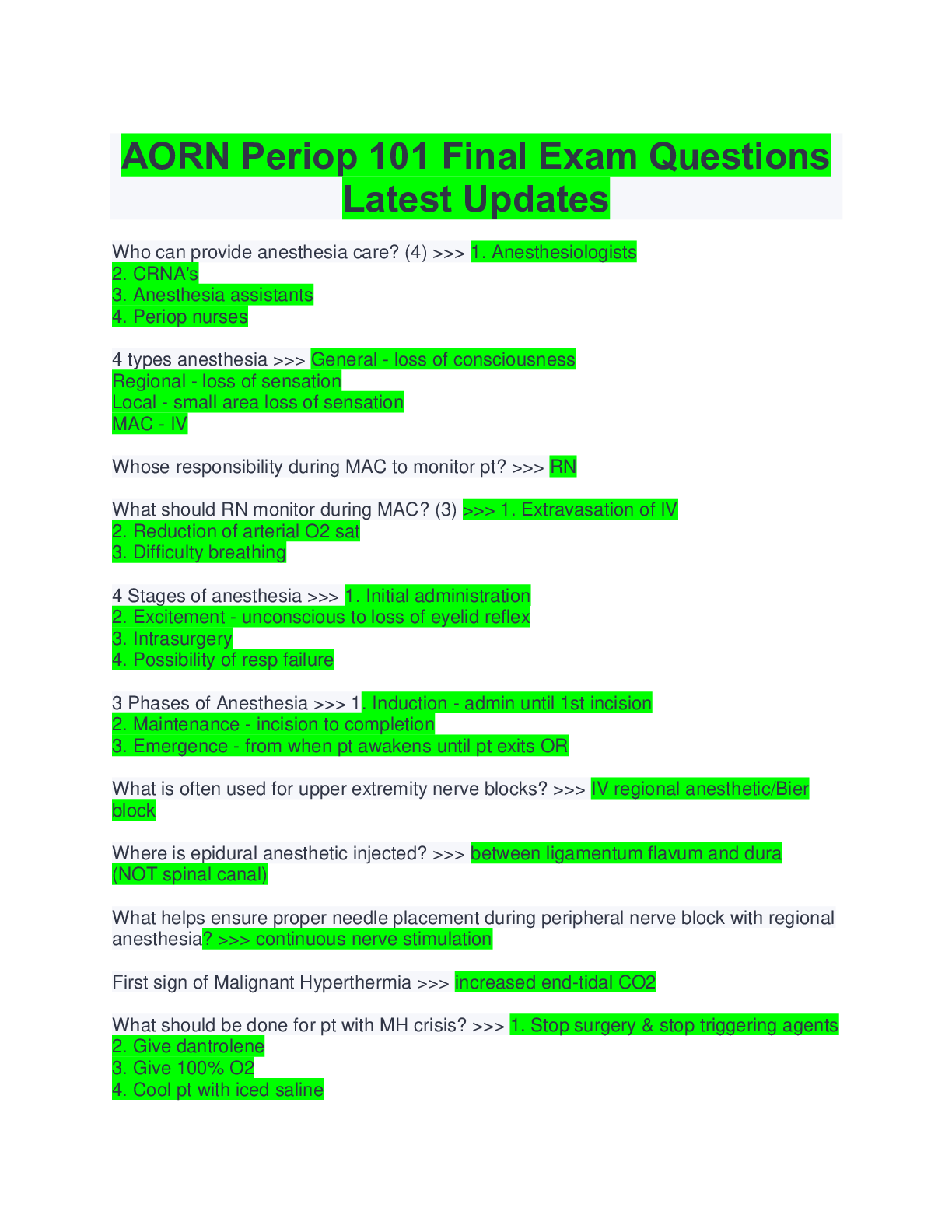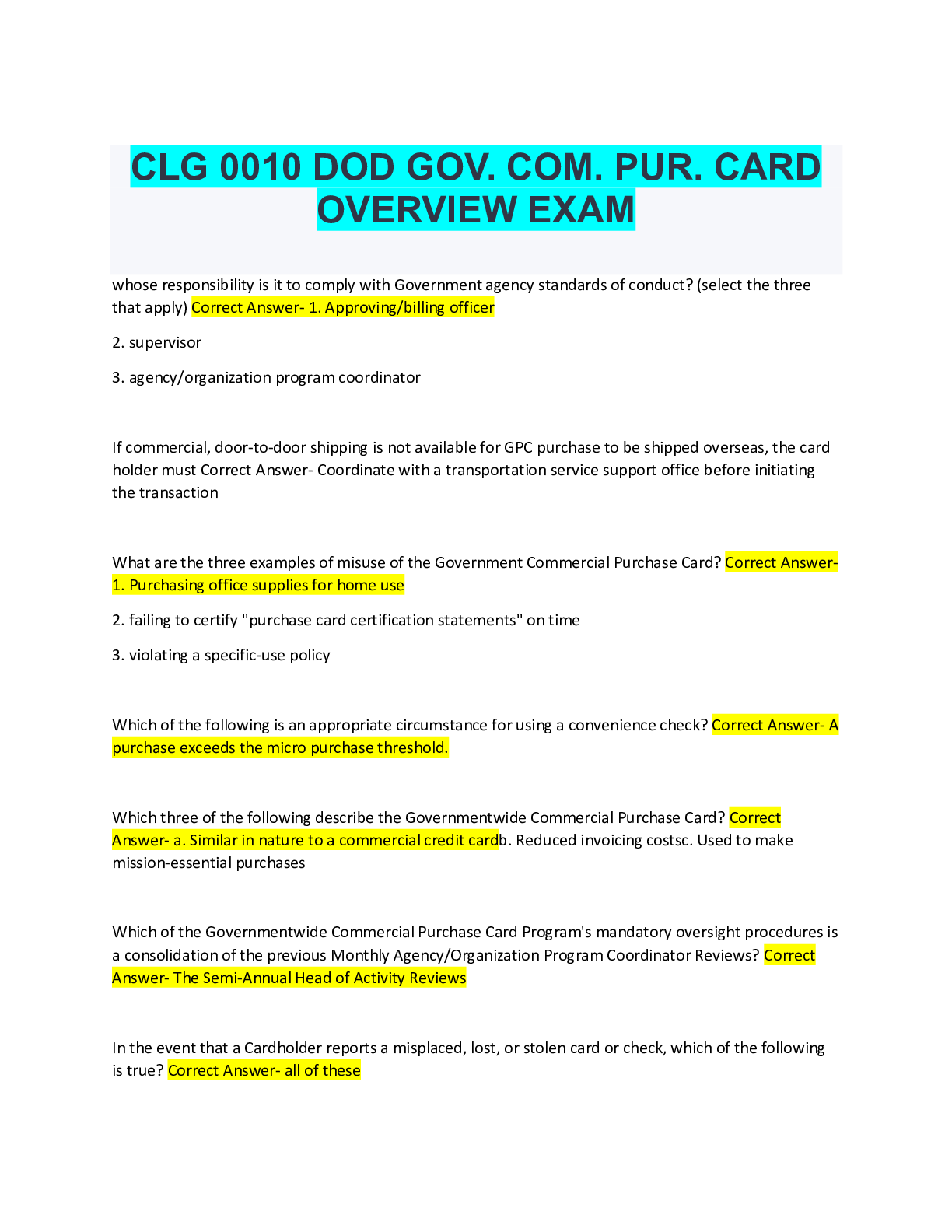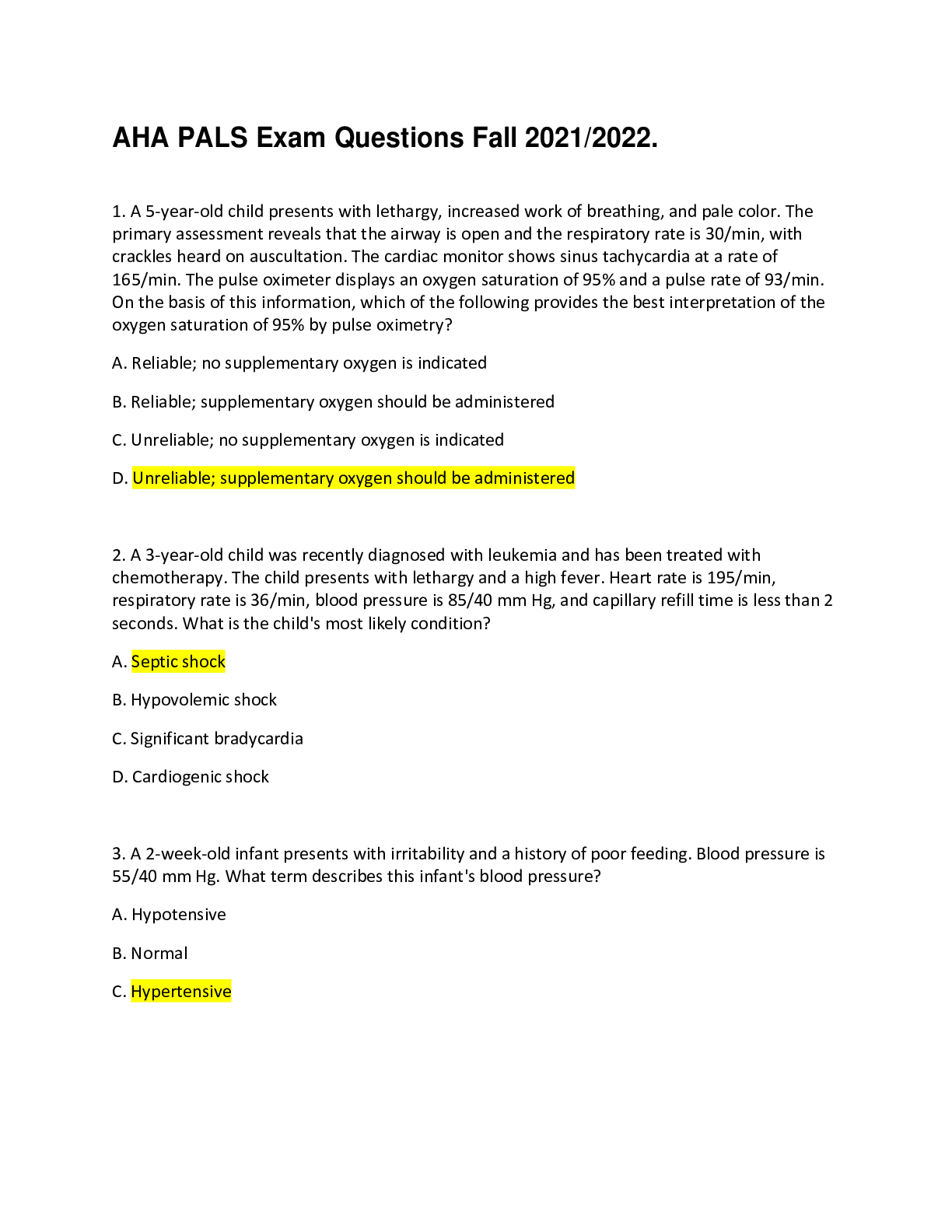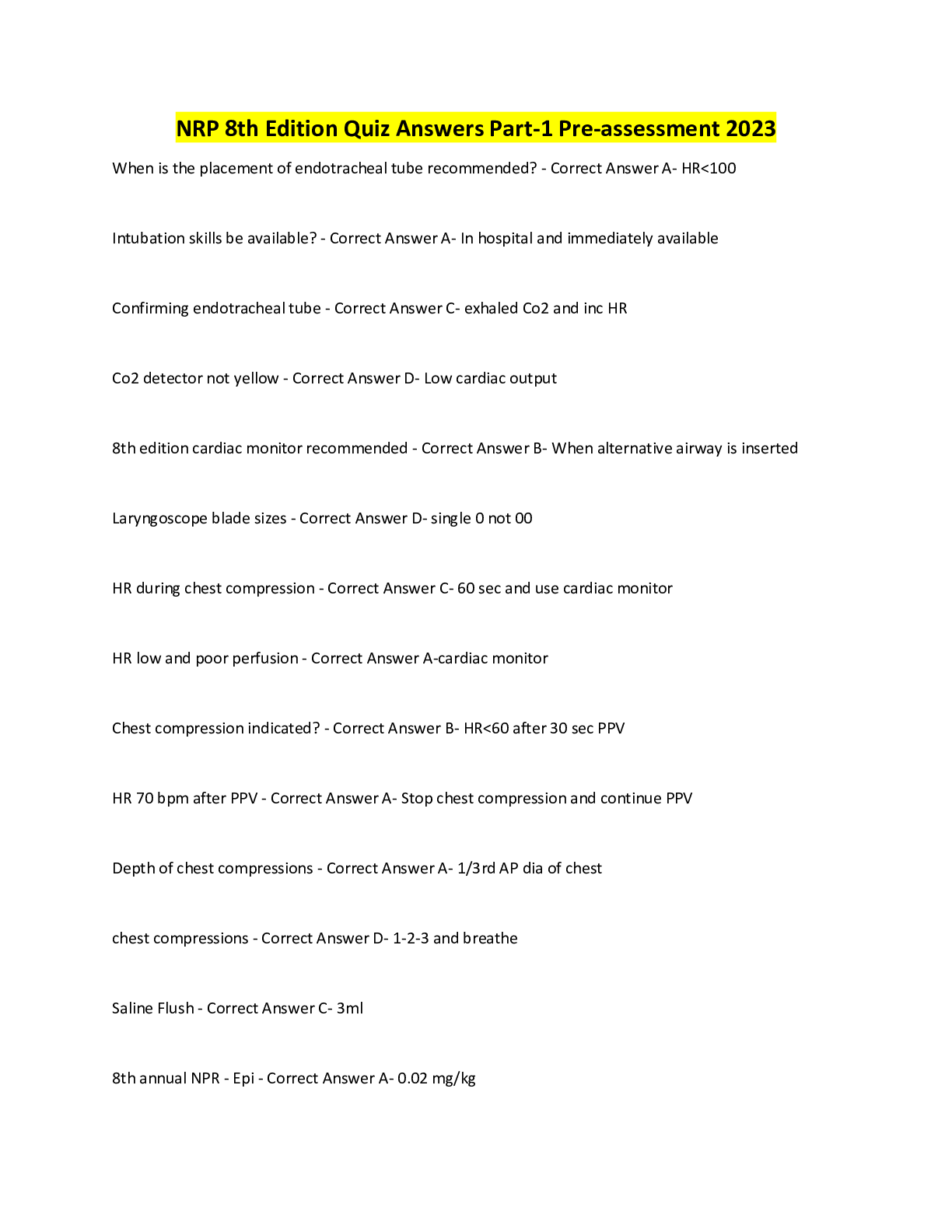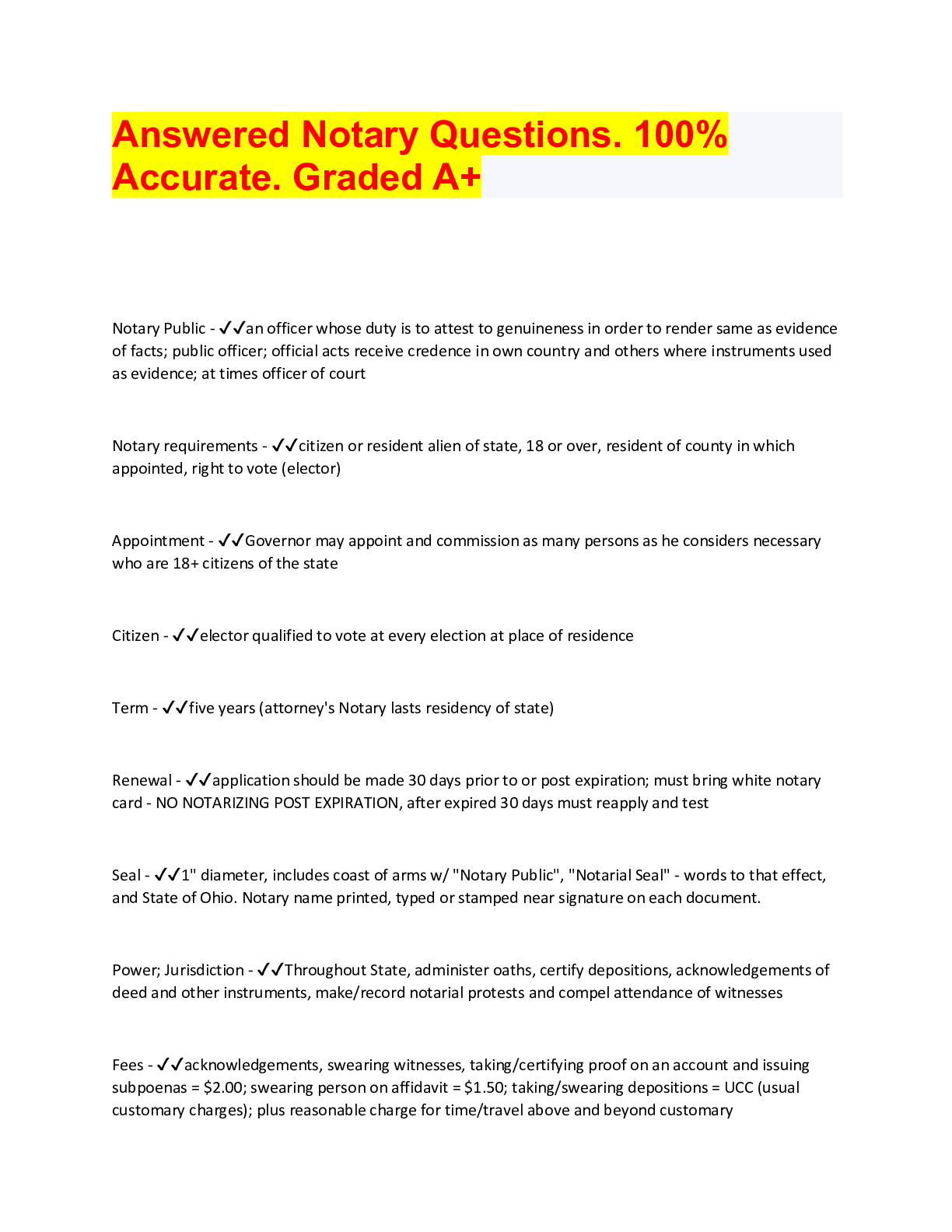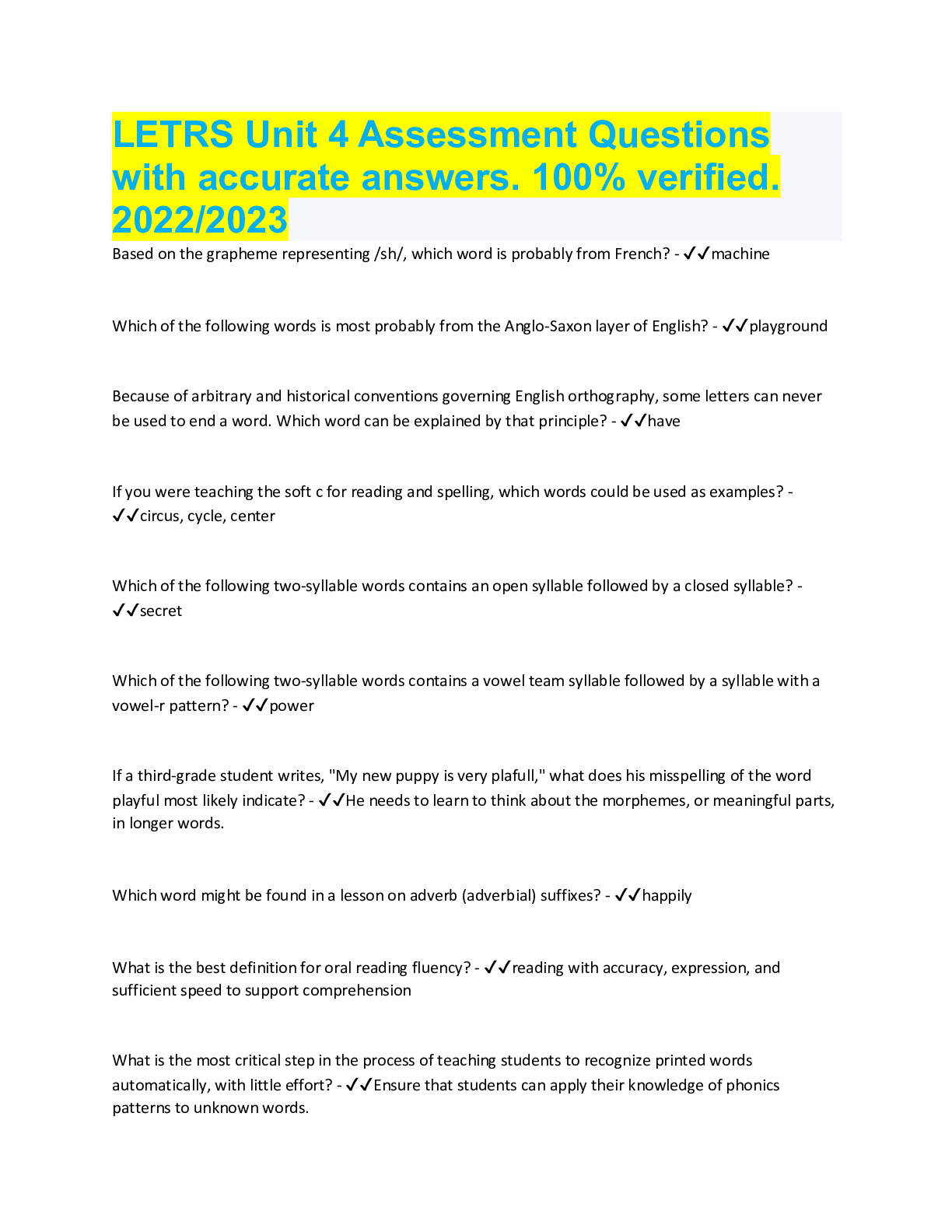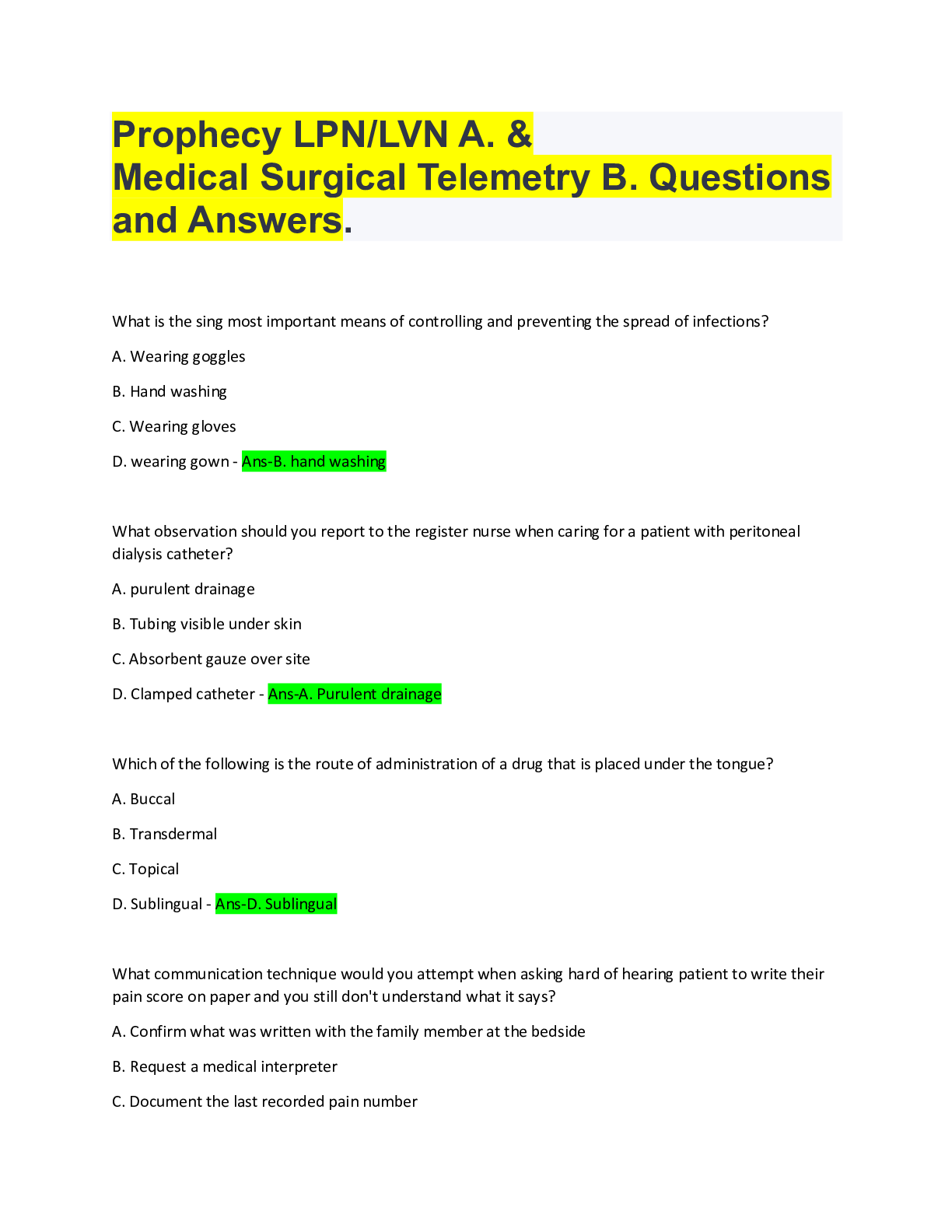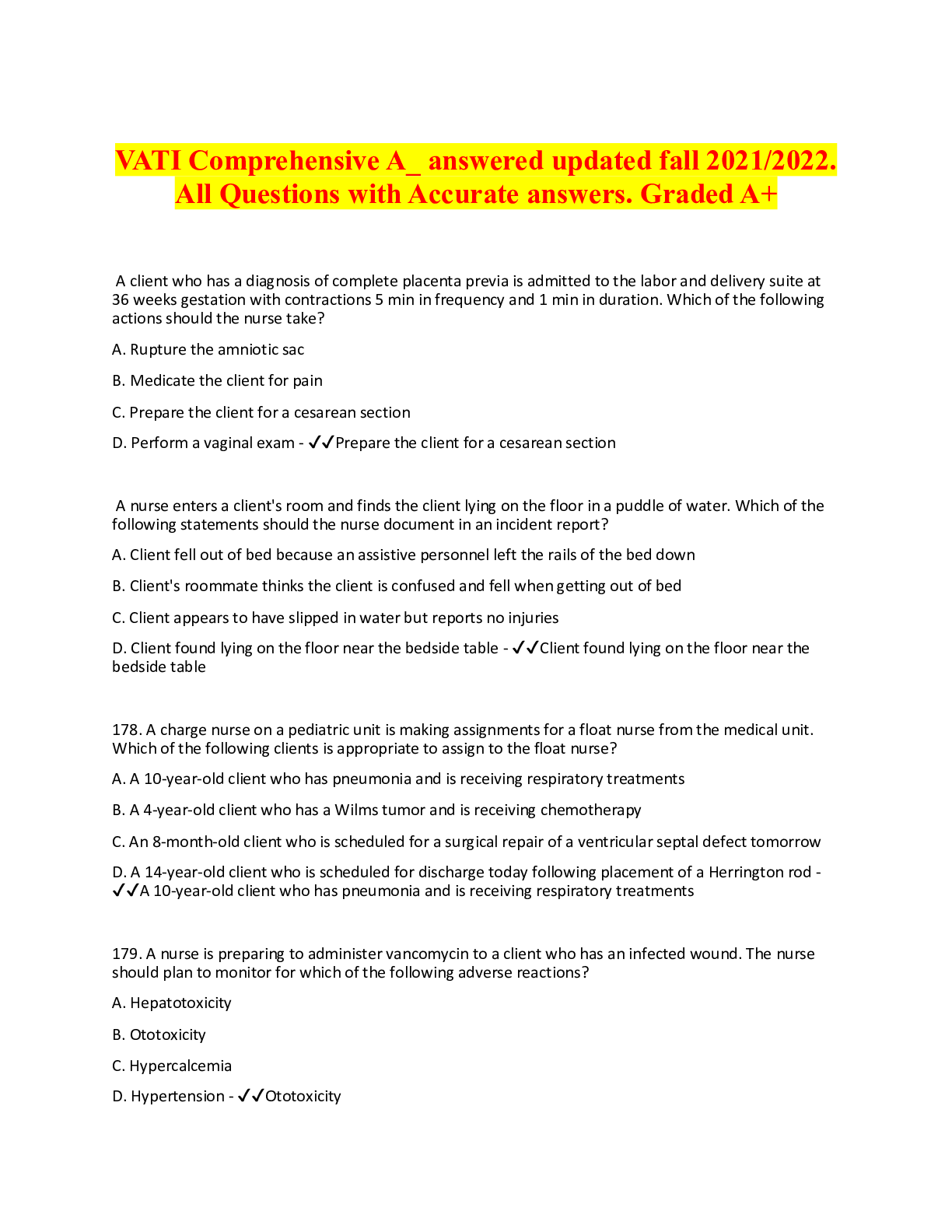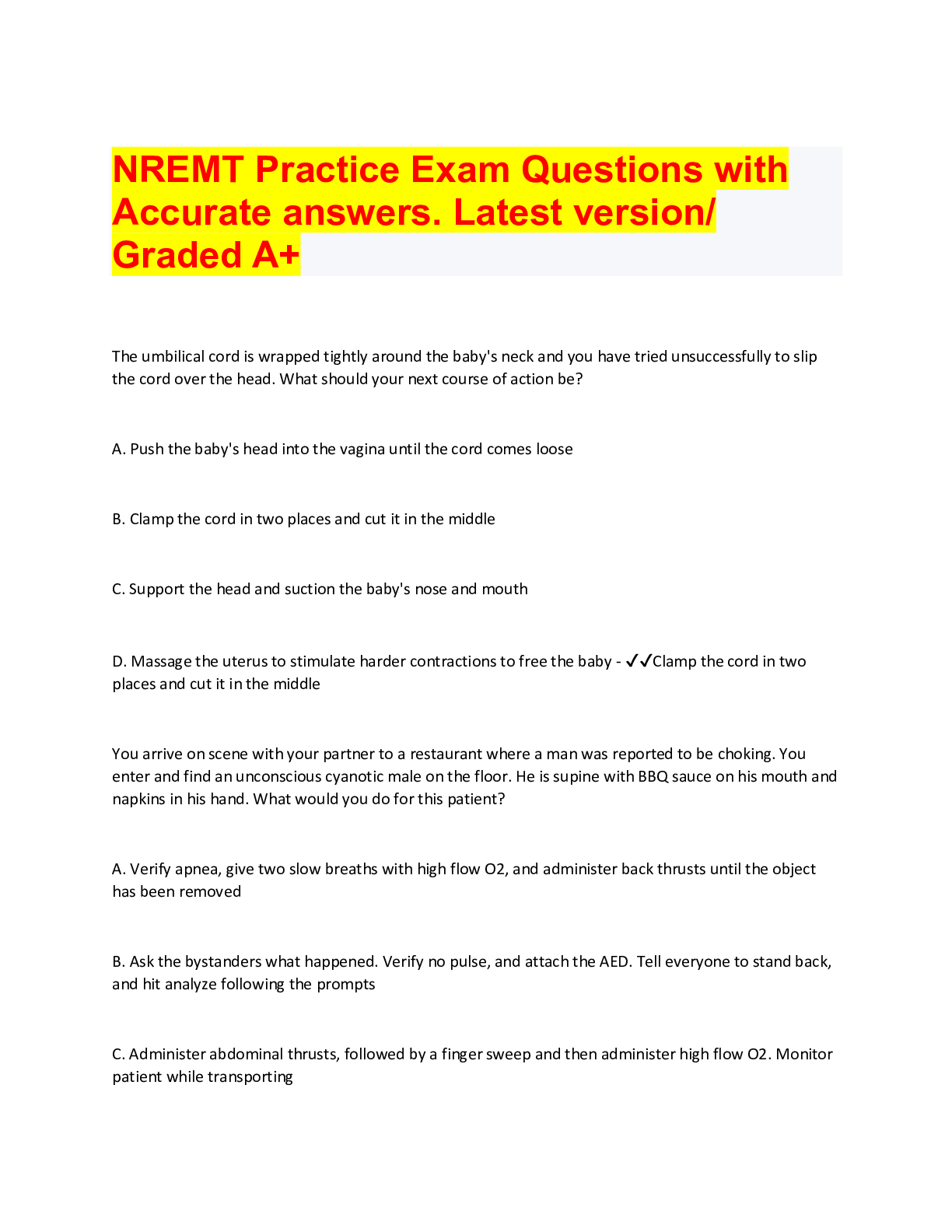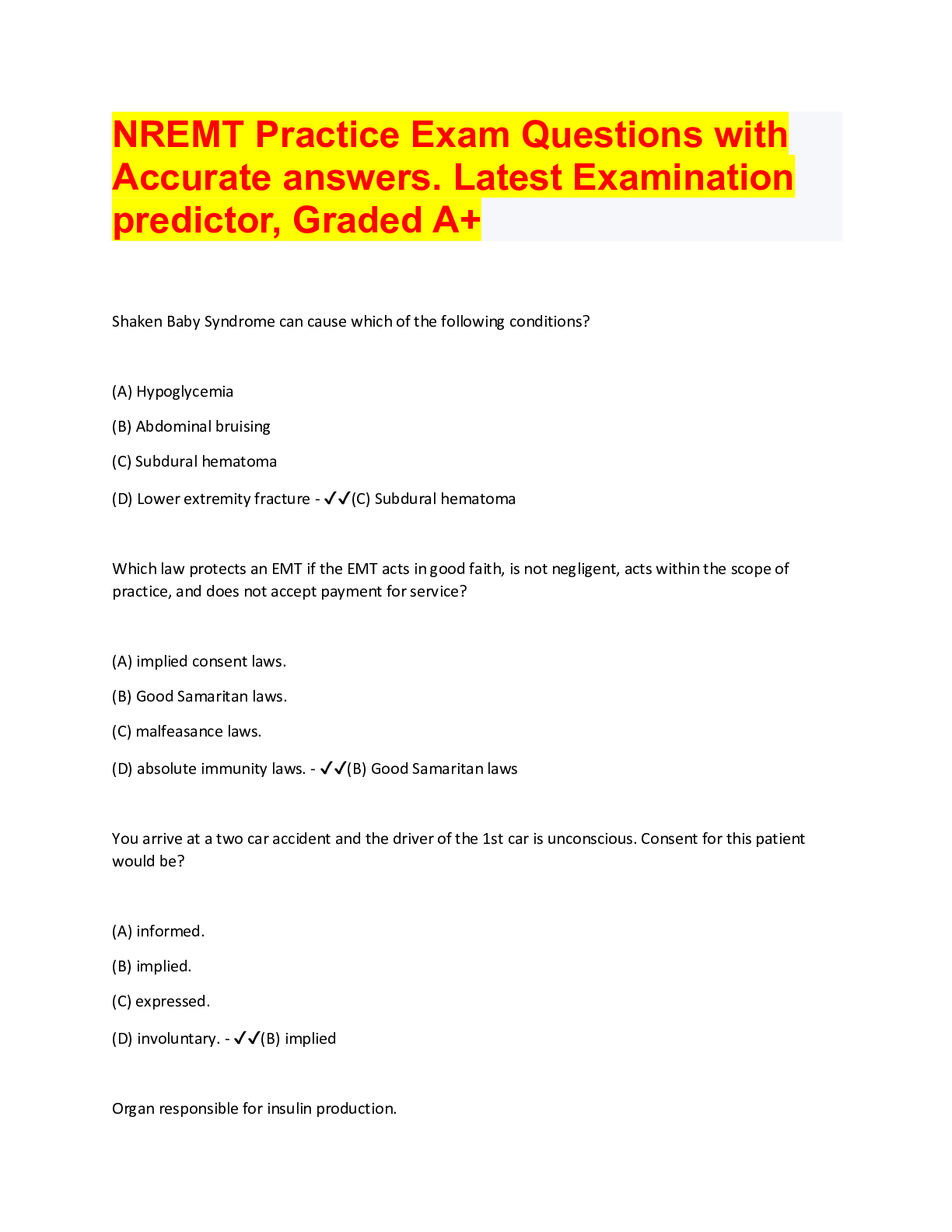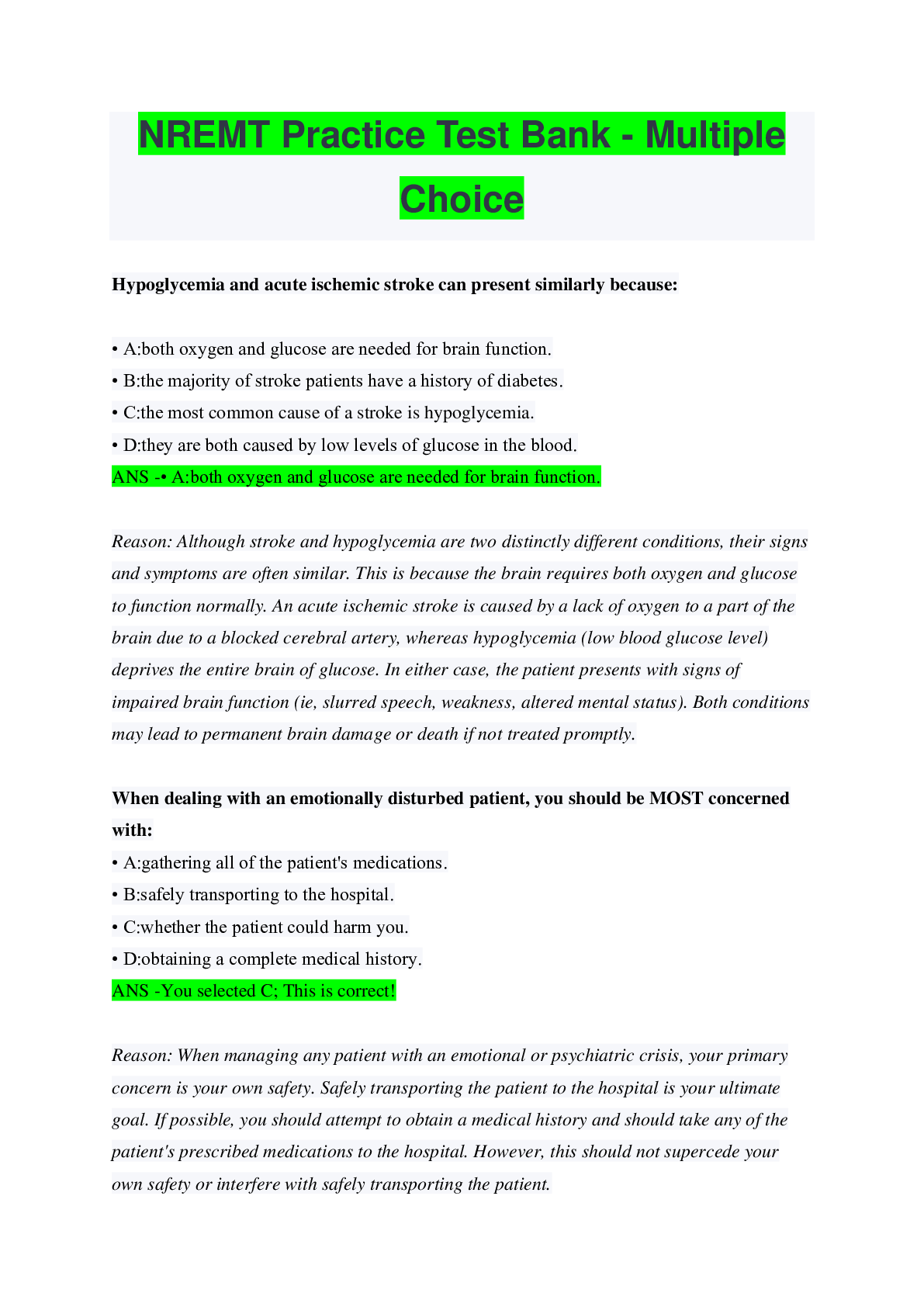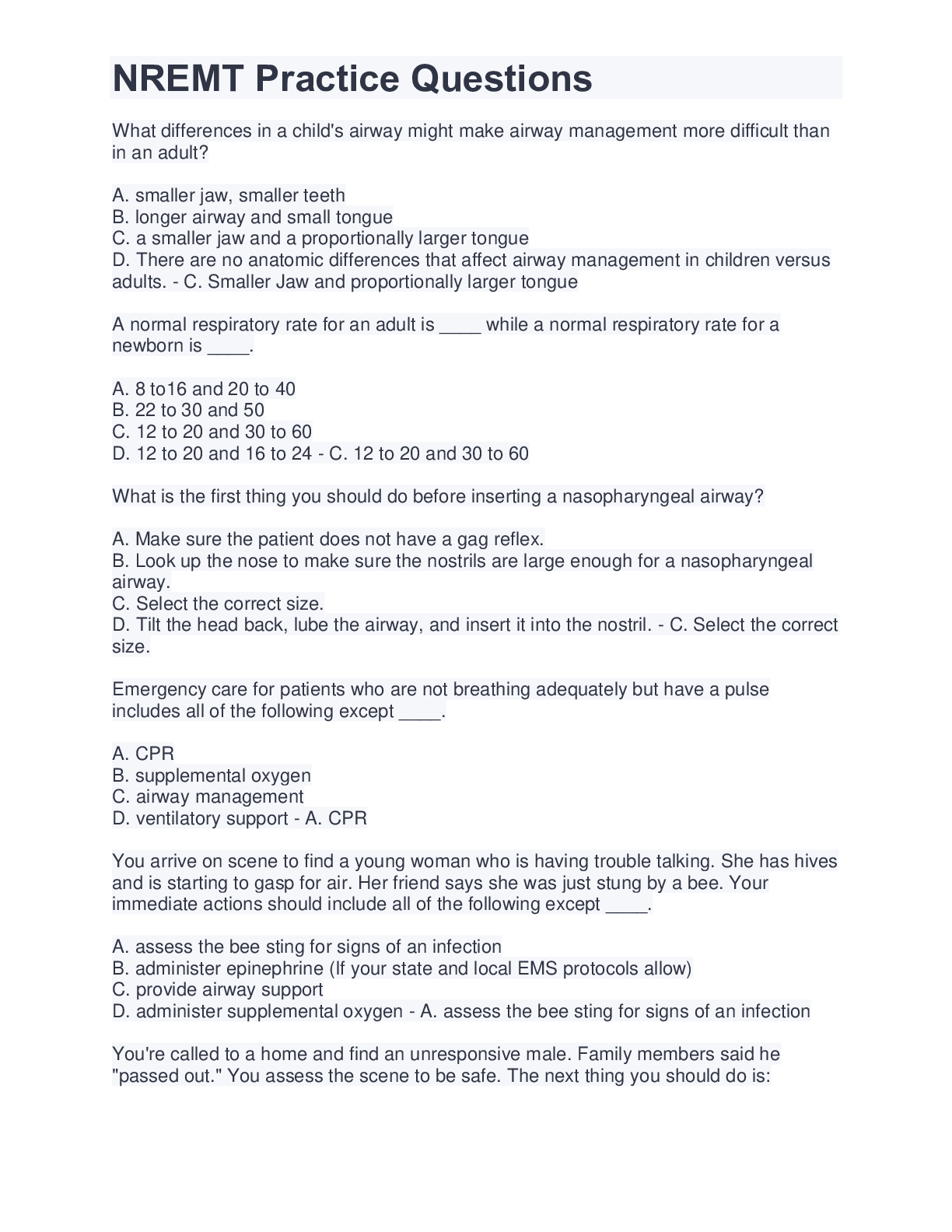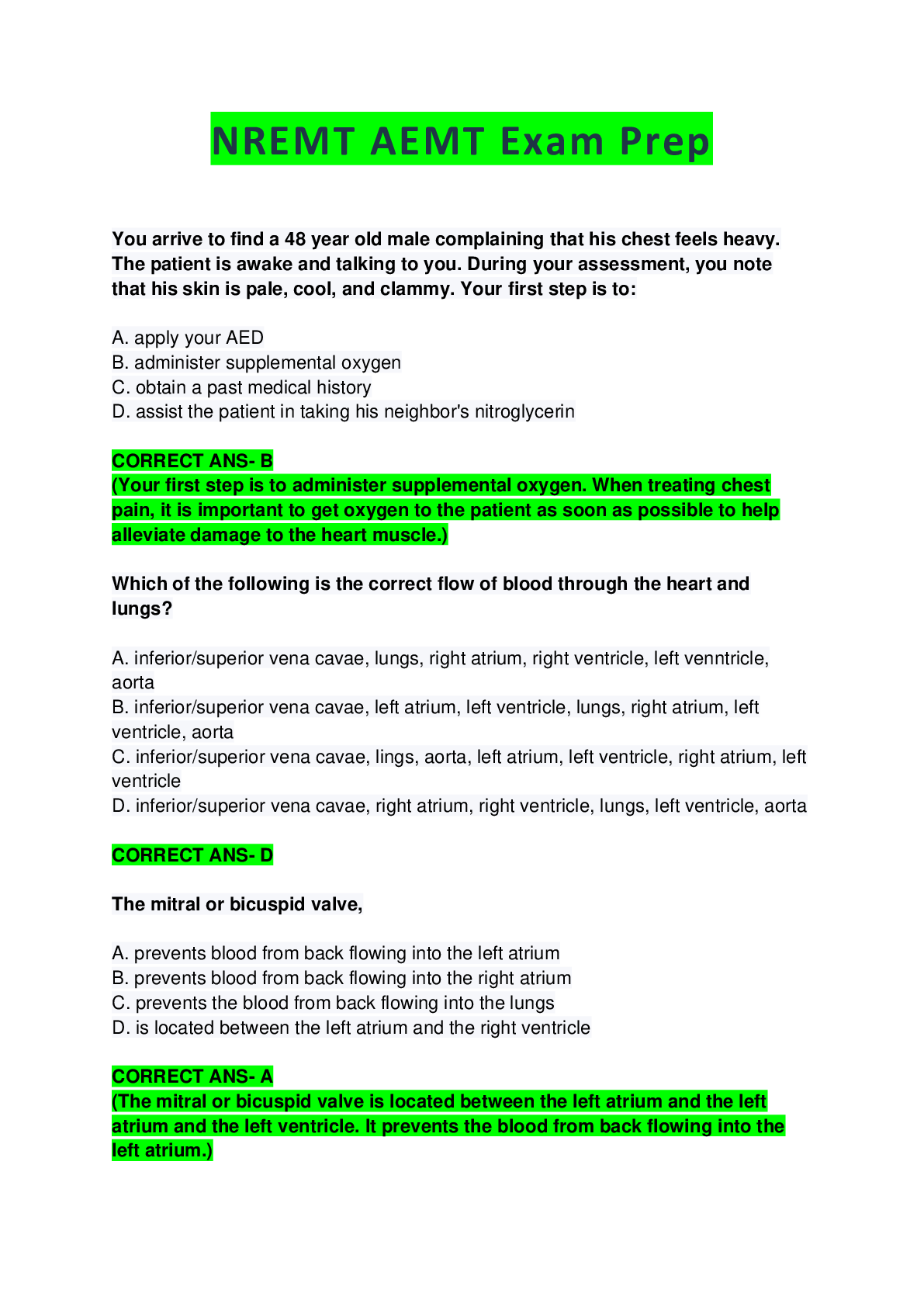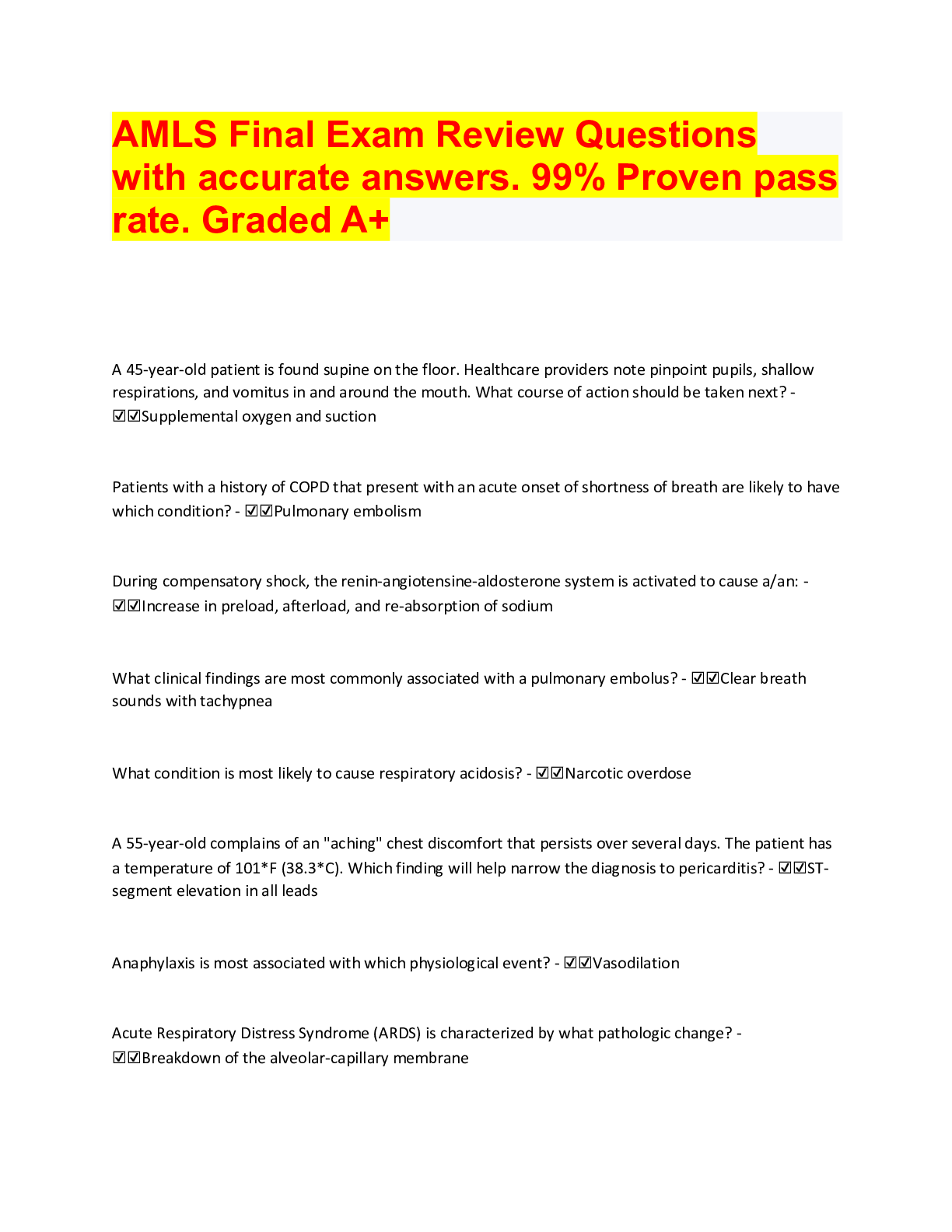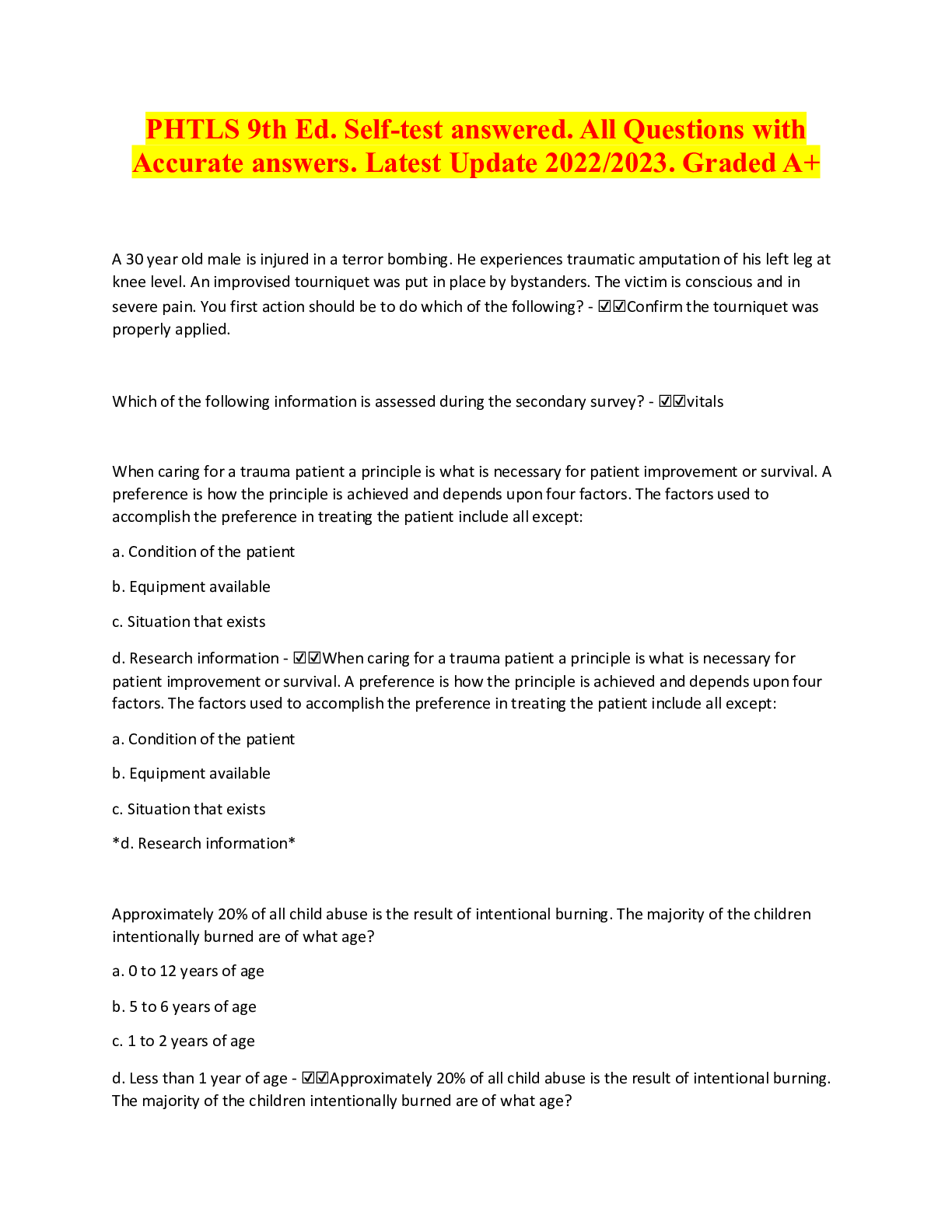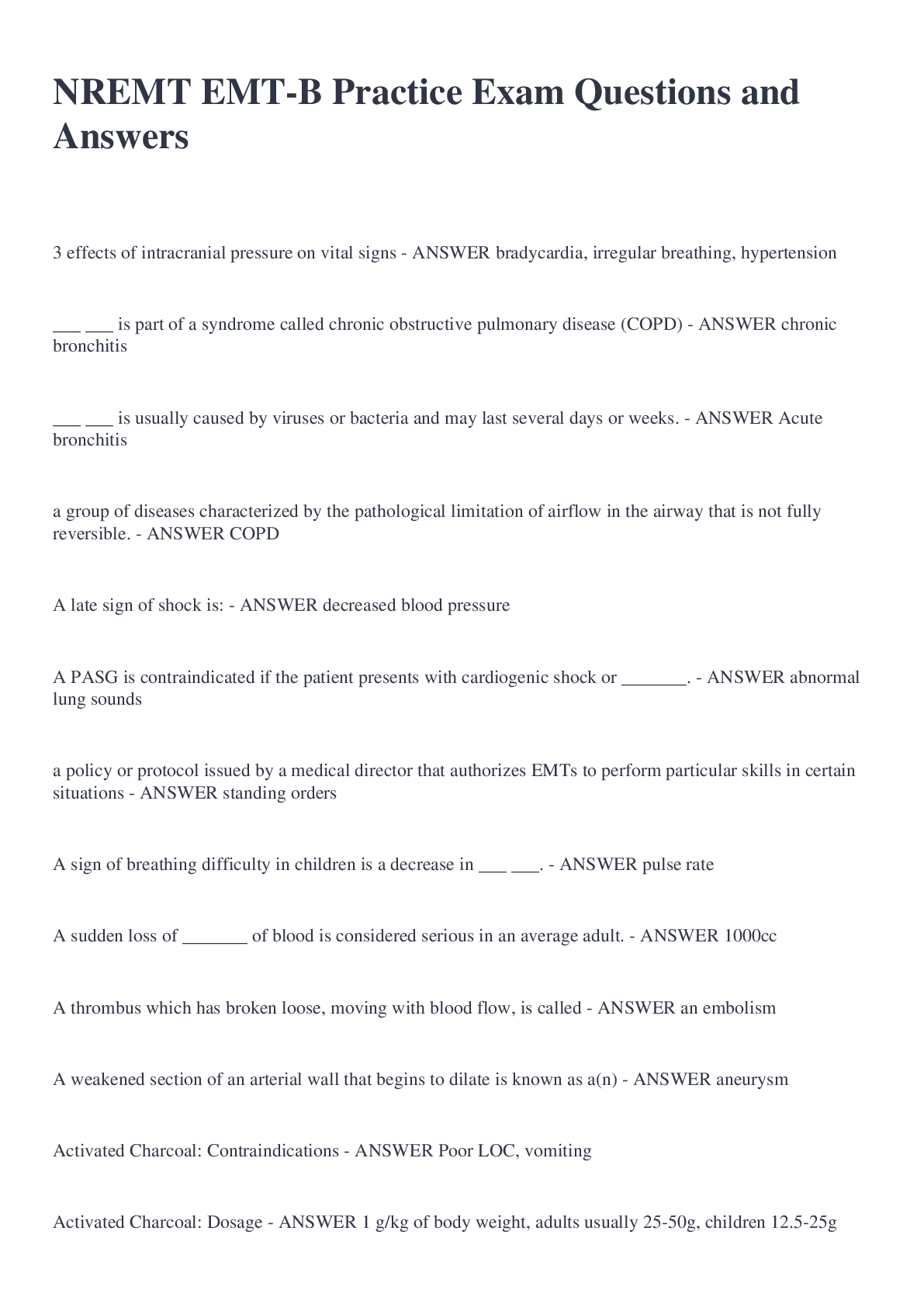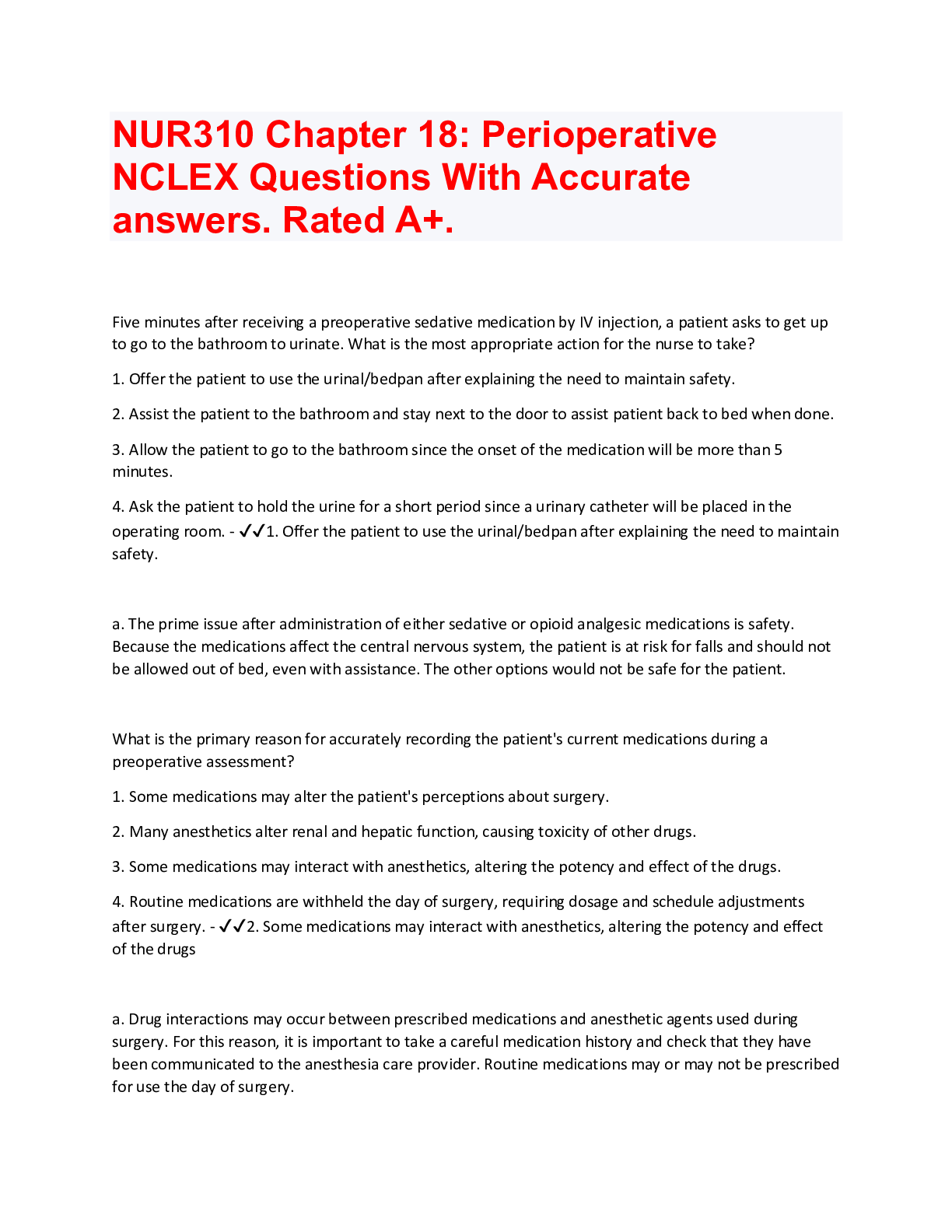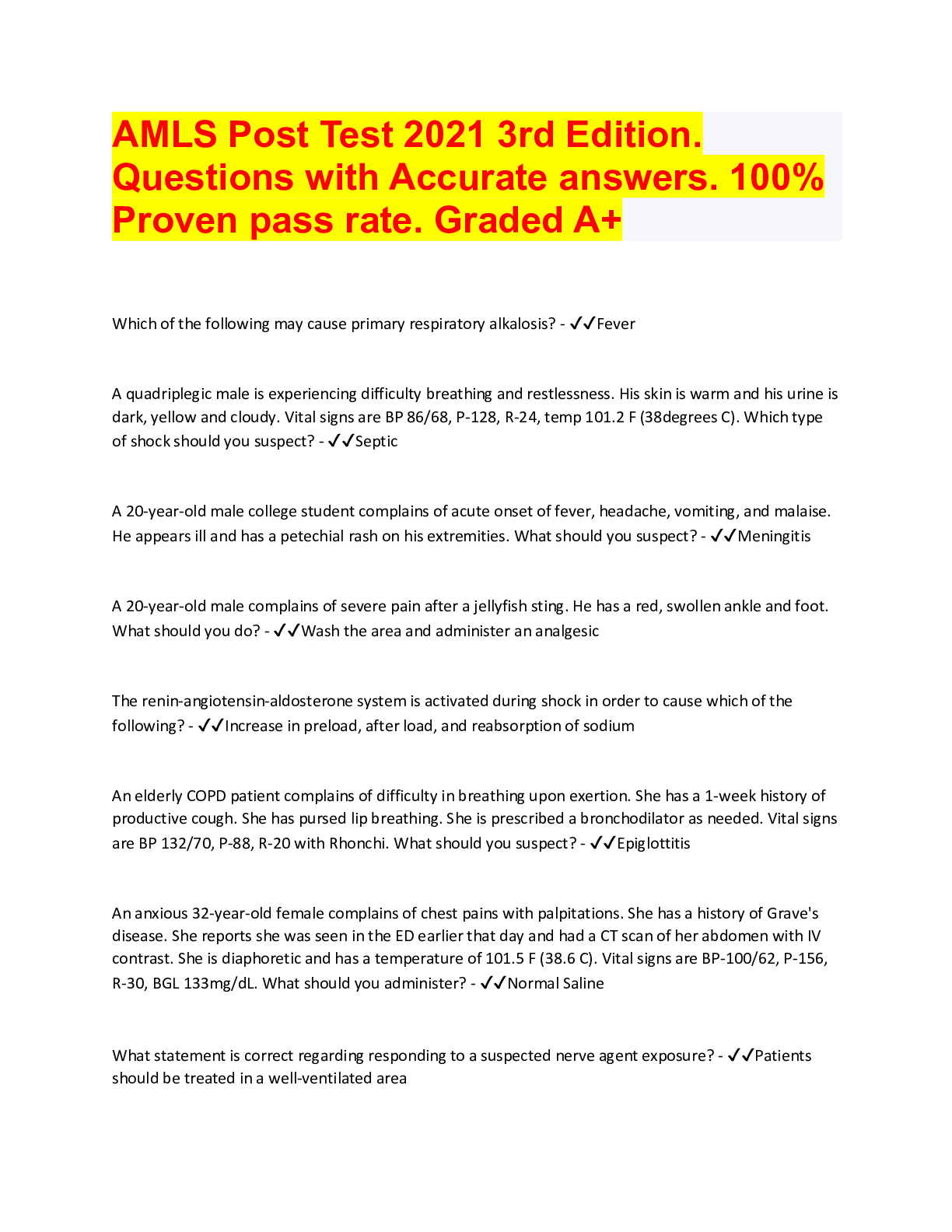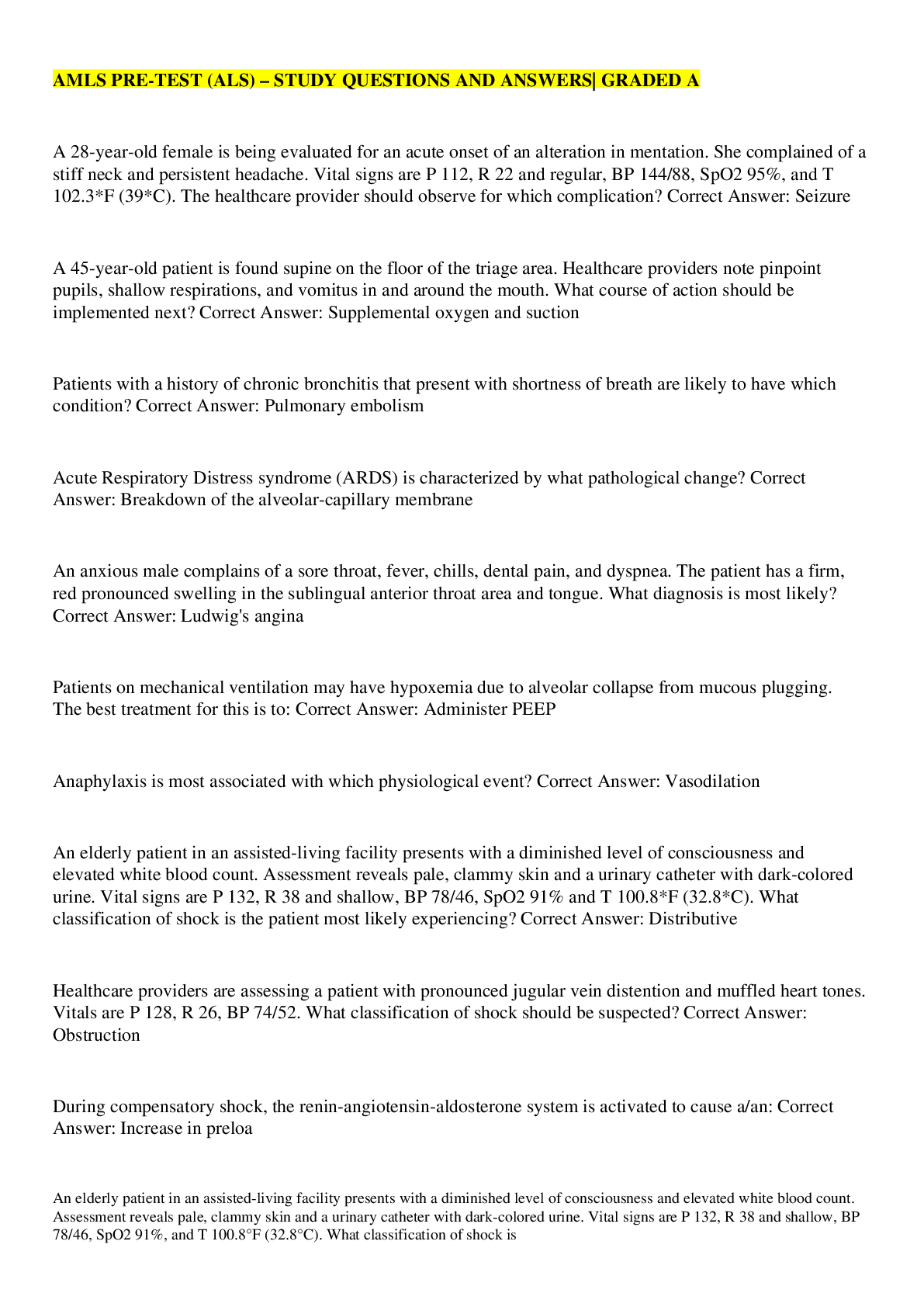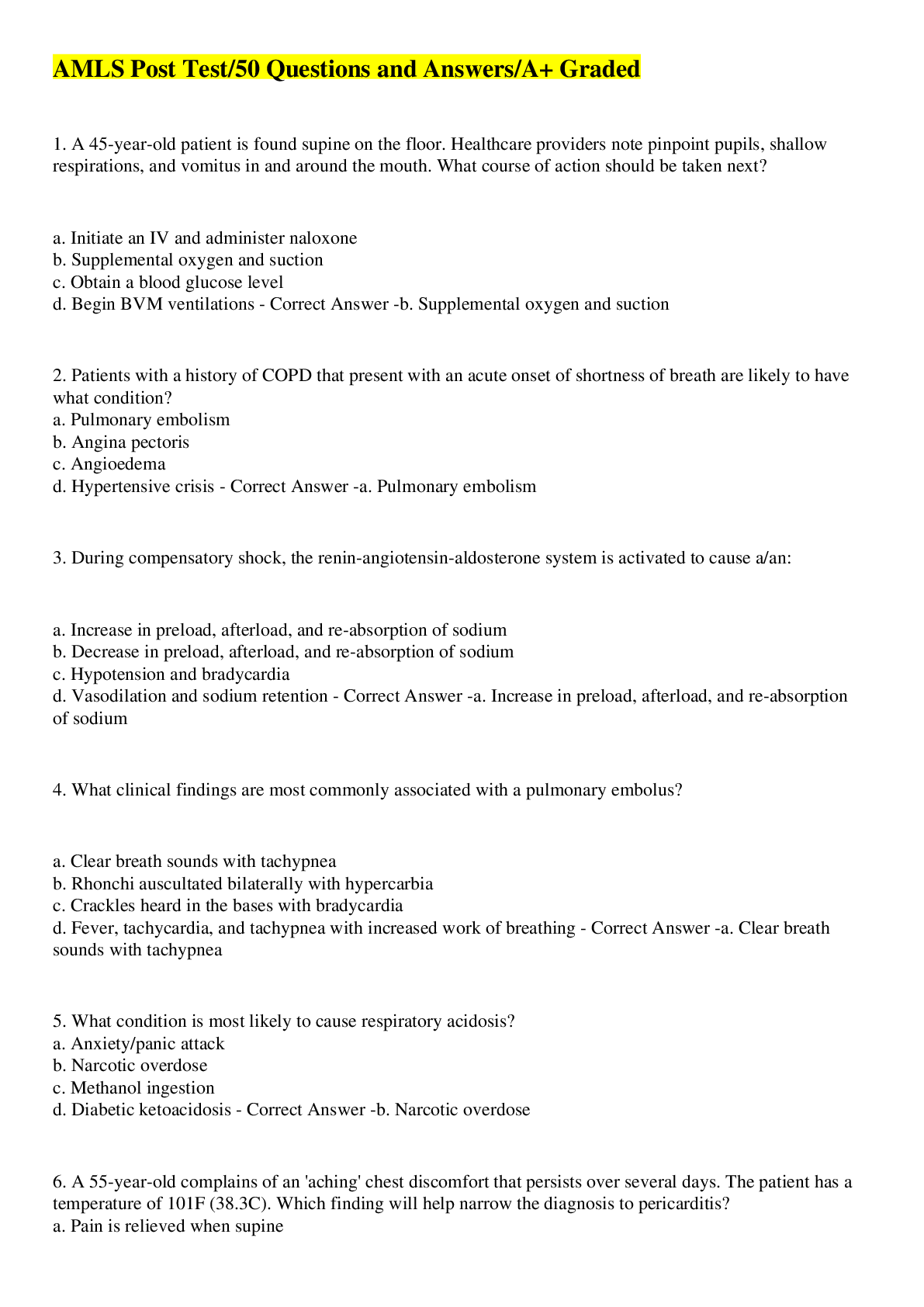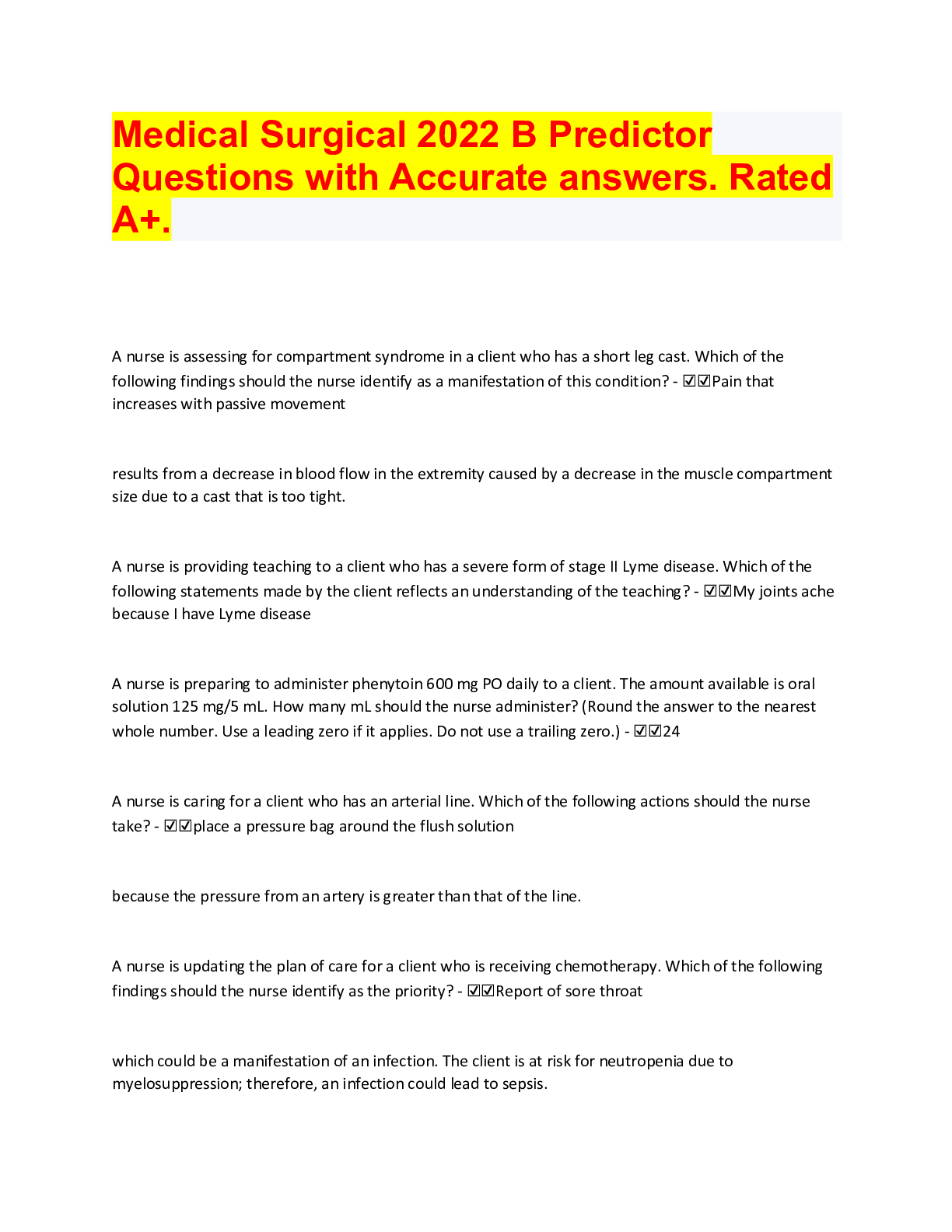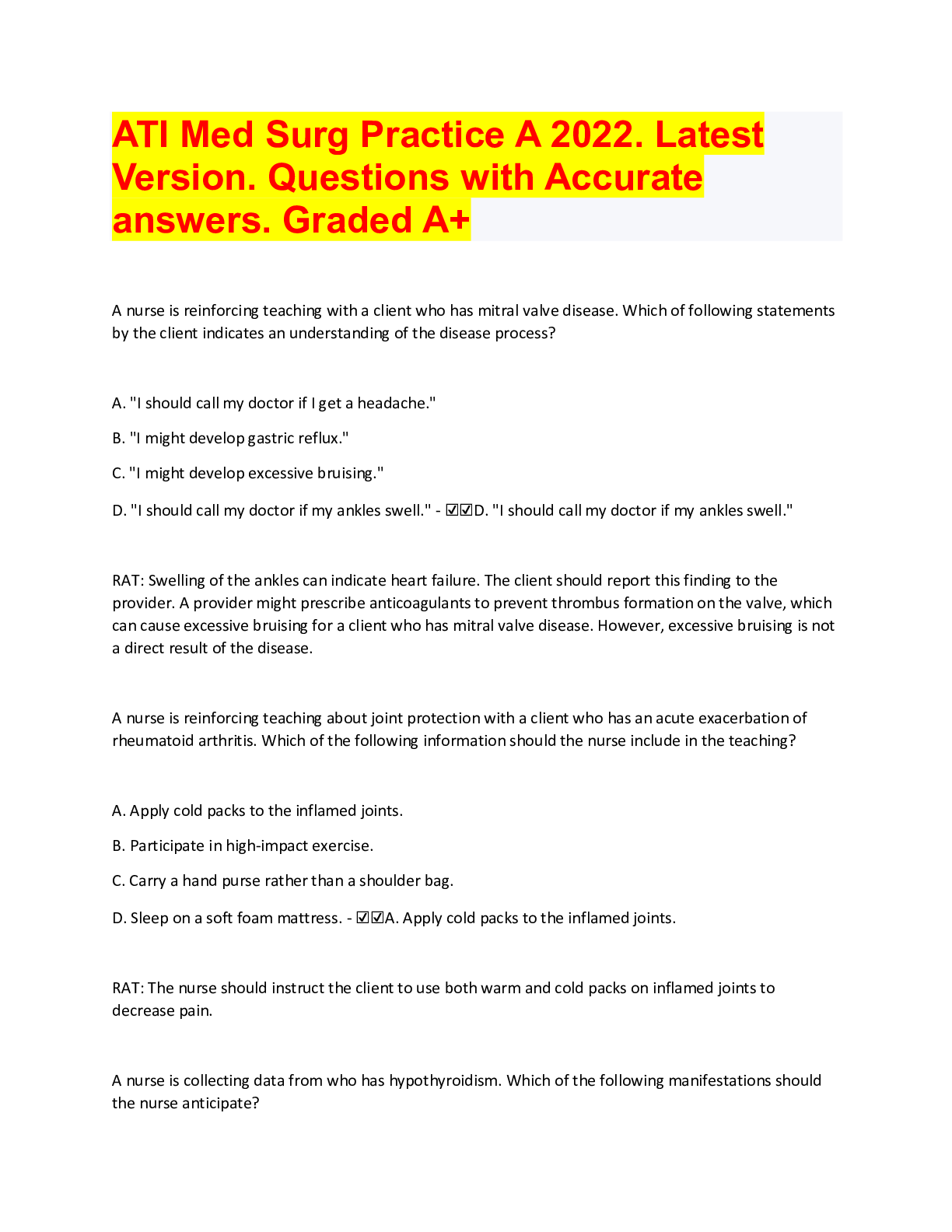*NURSING > QUESTIONS & ANSWERS > Questions bank, NREMT Cognitive Exam Prep. Examinable questions with accurate answers. Graded A+ (All)
Questions bank, NREMT Cognitive Exam Prep. Examinable questions with accurate answers. Graded A+
Document Content and Description Below
Where does the modern EMS system have its origin? - ☑☑The modern EMS system has its origins in funeral homes, which often operated ambulances. However, funeral home operators were often serving co... mpeting business interests and patients received little trained care until the hospital. What is considered the "birth" of EMS? - ☑☑In 1966, a paper titled "Accidental Death and Disability: The Neglected Disease of Modern Society" is published by the National Academy of Sciences. This paper is widely known in the EMS profession as the White Paper. The White Paper is widely considered the birth of modern EMS. It spotlighted inadequacies of prehospital care in the United States, particularly related to trauma. Who developed the first EMT National Standard Curriculum? - ☑☑Early in the 1970s, the US Department of Transportation developed the first EMT National Standard Curriculum. What are the levels of EMS training? - ☑☑Emergency Medical Responder (EMR): provides basic, immediate care including bleeding control, CPR, AED and emergency childbirth. Emergency Medical Technician (EMT): includes all EMR skills, advanced oxygen and ventilation skills, pulse oximetry, noninvasive blood pressure monitoring, and administration of certain medications. Advanced Emergency Medical Technician (AEMT): includes all EMT skills, advanced airway devices, intravenous and intraosseous access, blood glucose monitoring, and administration of additional medications. Paramedic: includes all preceding training levels, advanced assessment and management skills, various invasive skills, and extensive pharmacology interventions. This is the highest level of prehospital care outlined in the National EMS Education Standards. What are EMT roles and responsibilities? - ☑☑Equipment preparedness Emergency vehicle operations Establish, maintain scene safety Patient assessment and treatment Lifting and moving Strong verbal and written communication skills Patient advocacy Professional development Quality improvement Illness and injury prevention Maintain certification/licensure What is the role of the medical director? - ☑☑The medical director is a physician responsible for providing medical oversight. The medical director oversees quality improvement. What are the two types of medical direction? - ☑☑Online medical direction: direct contact between the physician and EMT via or radio. Offline medical direction: written guidelines and protocols. What is an EMT's first priority? - ☑☑The EMT's first priority is always his or her own safety. Scene safety is always the top priority! The EMT's safety priorities after personal safety are for his/her partner(s), patients and bystanders. What are the types of stress? - ☑☑Acute stress: an immediate physiological and psychological reaction to a specific event. Delayed stress: a stress reaction that develops after the stressful event. It does not interfere with the EMT's ability to perform during the stressful event. PTSD is an example of delayed stress. Cumulative stress: the result of exposure to stressful situations over a prolonged period of time. What are the stages of grief? - ☑☑Denial Anger Bargaining Depression Acceptance How can you prevent the risk of infection? - ☑☑Immediately report exposures to the designated infection control officer. Handwashing is the single most important way to prevent the spread of infection. Hand sanitizers can be effective, but soap and water is preferred when available. What are the two types of PPE? - ☑☑Minimum PPE: gloves and eye protection should be used during any patient contact situation. Expanded PPE: use disposable gown and mask for significant contact with any body fluid--for example, during childbirth. Use a high-efficiency particulate air (HEPA) mask o N-95 respirator for suspected airborne disease exposure, such as tuberculosis. What are emergency moves? - ☑☑These are used when the scene is dangerous and the patient must be moved before providing patient care. Types of emergency moves include the armpit-forearm drag, shirt drag, and blanket drag. What is an urgent move? - ☑☑Used when the patient has potentially life-threatening injuries or illness and must be moved quickly for evaluation and transport. Rapid extrication: an urgent move used for patients in a motor vehicle; it requires multiple rescuers and a long backboard. The patient is rotated onto a backboard with manual cervical spine precautions and removed from the vehicle. What are non-urgent moves? - ☑☑Used when there are no hazards and no life-threatening conditions are apparent. Types of non-urgent moves include direct ground lift, extremity lift, direct carry method, and draw sheet method. What is the log roll technique? - ☑☑Commonly used to place a patient on a backboard or assess the posterior. Can be done while maintaining manual cervical spine precautions. Should have at least three trained personnel. The person controlling manual cervical spine protection should direct the log roll. What are special considerations for bariatric patients? - ☑☑Obese patients pose additional challenges and risks to providers during lifting and movement. Some EMS systems have special bariatric ambulances with specialized equipment, automated lifting systems, and wider stretchers capable of a greater weight capacity. What is supine hypotensive syndrome? - ☑☑Patients in the later stages of pregnancy should not be placed supine due to the risk of supine hypotensive syndrome. Place the pregnant patient on her left side. If patient has potential cervical spine trauma, tilt backboard to the left about 20 degrees. When can patients be restrained? - ☑☑In general, patients may be forcibly restrained if they pose a significant, immediate threat to you, your partner, or others. Restraining a patient against his will is a last resort. Anticipate and plan. Request law enforcement assistance. Contact medical direction when possible. Guidelines for restraining a patient: -Get additional help whenever possible; at least 4 people is recommended. -Use the minimum amount of force necessary to protect yourself, the patient and others. -Secure patient supine, with backboard if available. DO NOT secure the patient in a prone position. -Use soft, padded restraints. -Monitor the patient's level of consciousness, airway, and distal circulation continuously. -Thoroughly document the reason for restraining the patient, the method of restraint, the duration of restraint, and frequent reassessment of the patient while restrained. What is the use of force doctrine? - ☑☑The EMT must act reasonably to prevent harm to a patient being forcibly restrained. The use of force must be protective, not punitive. What is scope of practice? - ☑☑Scope of practice outlines the actions a provider is legally allowed to perform based on his or her license or certification level. Scope of practice is tied to the licensure or certification, not the individual's knowledge or experience. Each state determines the scope of practice for its EMS providers. What is standard of care? - ☑☑Standard of care is the degree of care a reasonable person with similar training would provide in a similar situation. Standard of care requires EMTs to competently perform the indicated assessment and treatment within their scope of practice. What are sources that help establish standard of care? - ☑☑National EMS Education Standards State protocols and guidelines Medical direction EMS agency's policies and procedures Reputable textbooks Care considered acceptable by similarly trained providers in the same community. What is informed consent? - ☑☑Informed consent is required from all patients who are alert and competent. -Patient must be informed of your carer plan and associated risks of accepting or refusing care and transport. -Patient must be informed of, and understand, all information that would impact a reasonable person's decision to accept or refuse care and transport. What is expressed consent? - ☑☑Expressed consent also requires that the patient be alert and competent to give expressed consent. Expressed consent can be given verbally or nonverbally. -Expressed consent is similar to informed consent, but not usually as in-depth as informed consent. -Expressed consent is often used to obtain consent for more basic assessments or procedures. What is implied consent? - ☑☑Implied consent allows assumption of consent for emergency care from an unresponsive or incompetent patient. -Patients might be incompetent for many reasons, such as alcohol, drugs, head injury, hypoxia, hypoglycemia, or mental incompetency. -Implied consent can be used to treat a patient who initially refused care but later loses consciousness or becomes otherwise incapacitated. What is minor consent? - ☑☑Minors are not competent to accept or refuse care. -Consent is required from a parent or legal guardian. Implied consent can be used when unable to reach a parent or guardian and treatment is needed. -Minor consent is not required for emancipated minors. Criteria for emancipation varies but usually includes minors who are married or pregnant, already a parent, a member of the armed forces, financially independent, or emancipated by the courts. What is involuntary consent? - ☑☑Involuntary consent is used for mentally incompetent adults or those in custody of law enforcement. Consent must be obtained from the entity with the appropriate legal authority. What are advance directives? - ☑☑Advance directives are written instructions, signed by the patient, specifying the patient's wishes regarding treatment and resuscitative efforts. There are several types of advance directives. -Do Not Resuscitate (DNR): DNRs are specific to resuscitation efforts and do not affect treatment prior to the patient entering cardiac arrest. -Living will: Living wills are broader than DNRs. They address health care wishes prior to entering cardiac arrest. This may include use of advanced airways, ventilators, feeding tubes, etc. How do Good Samaritan Laws affect EMTs? - ☑☑Good Samaritan laws are designed to protect someone who renders care as long as he or she is not being compensated and gross negligence is not committed. -Each state has some form of Good Samaritan laws. Some protect health care providers, but some do not. -Some states extend their Good Samaritan law to publicly employed EMS providers but not to those in the private sector. What is assault? - ☑☑A person can be guilty of assault even if another person only perceived that they intended to inflict harm. Physical contact is not required to be guilty of assault. What is battery? - ☑☑Battery is physically touching another person without their consent. What is negligence? - ☑☑Negligence is the most common reason EMS providers are sued civilly. -The plaintiff has the burden of proof, not the EMT. -With negligence, the EMS provider is accused of unintentional harm to the plaintiff. What are the four components of negligence? - ☑☑The plaintiff must prove all four of the following: 1. Duty to act: the EMT had an obligation to respond and provide care. 2. Breach of duty: the EMT failed to assess, treat, or transport patient according to the standard of care. 3. Damage: the plaintiff experienced damage or injury recognized by the legal system as worthy of compensation. 4. Causation: the injury to the plaintiff was, at least in part, directly due to the EMT's breech of duty. What is gross negligence? - ☑☑Gross negligence exceeds simple negligence. Gross negligence involves an indfference to, and violation of, a legal responsibility. Reckless patient care that is clearly dangerous to the patient is grossly negligent. Gross negligence can result in civil and/or criminal charges. What is abandonment? - ☑☑Once care is initiated, EMS providers cannot terminate care without the patient's consent. Some patient encounters may also require direct contact with medical direction prior to terminating care. Most EMS agencies have written protocols for terminating care without transporting the patient to a higher level of care. Abandonment is the termination of care without transferring the patient to an equal or higher medical authority. Transfer of care must include a verbal report to an equal or higher medical authority. Most EMS systems allow EMTs to accept care from a paramedic or advanced EMT for transport if an advanced-level assessment or advanced care is not needed. What is false imprisonment? - ☑☑You may be guilty of false imprisonment if you transport a competent patient without consent. What factors influence hospital determination? - ☑☑Destination factors include: -The patient's request or medical direction -The closest appropriate facility or specialty facility -Written protocols or triage guidelines -Hospital diversion or bypass A patient's ability to pay should NOT factor into where a patient is transported. When in doubt, consult medical direction. Thoroughly document why the destination was chosen. This is especially true if you bypass a closer hospital capable of managing your patient. What are patient refusals? - ☑☑Competent patients may refuse treatment regardless of the severity of their condition. -Refusals present high liability risk for EMS providers. -Negligence or abandonment can be much easier to provide if the patient is not transport. -Consider requesting advanced life support personnel or contacting medical direction per local protocols. -During a refusal, the patient must be fully informed of the treatment recommended and the possible consequences of refusing treatment. -The patient is rarely, if ever, fully informed the first time he or she conveys the intent to refuse treatment. Documentation should reflect both the initial refusal and the second refusal after being fully informed. What factors determine whether a patient is competent or not? - ☑☑Typically, competency requires awareness of at least four things: -Person: the patient knows his or her name. -Place: the patient knows where he or she is. -Time: the patient is aware of the date and time. -Event: the patient is aware of his or her present circumstances. How can an EMT reduce liability on patient refusal? - ☑☑1) The EMTs best protection from liability is to provide excellent care and convince the patient to accept transport. 2) The second best way for an EMT to protect himself or herself is to ensure the patient is fully informed, contact medical direction, and document extremely well. When can EMTs release confidential patient information? - ☑☑EMTs can release confidential patient information without consent when: -The information is necessary for continuity of care -The information is necessary to facilitate billing for services -The EMT has received a valid subpoena -Reporting possible crimes, abuse, assault, neglect, certain injuries or communicable diseases What is HIPAA? - ☑☑Health Insurance Portability and Accountability Act (HIPAA) -HIPAA is a federal law established in 1996 and has had a huge impact on health care. HIPAA improved privacy protection of patient health care records. -HIPAA gives patients greater control over how health care records are used and transferred. -EMS agencies are mandated to provide HIPAA training to all employees who have any contact with patients or patient records. -EMS providers must provide patients with privacy practices and obtain signature of receipt. What are COBRA and EMTALA? - ☑☑Consolidated Omnibus Budget Reconciliation Act (COBRA) and Emergency Medical Treatment and Active Labor Act (EMTALA) -COBRA and EMTALA include federal regulations guaranteeing public access to emergency care. -COBRA and EMTALA are also intended to stop the inappropriate transfe of patients, known as a patient "dump." What are considered obvious signs of death? - ☑☑The following are typically considered obvious signs of death indicating that resuscitation should not be initiated: -Decomposition -Rigor mortis -Dependent lividity -Decapitation On what kind of scenes must law enforcement be notified? - ☑☑1. Any scene where the patient is dead on arival 2. Suicide attempts 3. Assault or sexual assault 4. Child abuse or elder abuse 5. Suspected crime scene 6. Childbirth How should EMT's operate in crime scenes? - ☑☑1. Ensure scene safety 2. Provide patient care as needed 3. Avoid any unnecessary disturbance of scene 4. Remember and note the position of patient(s) 5. Remember and report everything you touched at the scene 6. Cut around (not through) holes in clothing when exposing the patient 7. Note anything or anyone suspicious on or near the scene 8. Discourage sexual assault patients from changing clothes or showering 9. Try to get a same-sex provider to assist with sexual assault patients 10. Leave once you are no longer needed at the scene What are therapeutic communications? - ☑☑Therapeutic communications typically refers to your interaction with the patient and ability to obtain clinical information. What are portable and mobile radios? - ☑☑Portable radios: hand-held transmitter/receiver with a very limited range, unless used with a repeater. Mobile radios: vehicle-mounted transmitters and receivers. These have a greater range than portable radios, but distance is still limited unless used with a repeater. What is a repeater? - ☑☑A type of base station that receives low-power transmissions from portable or mobile radios and rebroadcasts at higher power to improve range. What is a base station? - ☑☑A transmitter/receiver in a fixed location that is in contact with all other components in the radio system. Who regulates all radio operations in the US? - ☑☑The Federal Communications Commission (FCC) regulates all radio operations in the US and has allocated specific frequencies for EMS use only. How should you communicate with dispatch? - ☑☑1. Confirm receipt of dispatch. 2. Notify dispatch when en route to the call,on scene, en route to the hospital, and at the hospital. A. Identify who you are talking to first, then who you are. B. Use "affirmative" or "negative," not "yes" or "no." C. Use "copy" to confirm receipt of a transmission. D. Always "echo" orders from medical direction to confirm accuracy. E. DO NOT use unnecessary verbiage such as "please" or "thank you." How should you communicate with medical direction? - ☑☑Sample format: -Unit designation, certification level, destination and estimate time of arival -Patient's age, sex, and chief complaint -Patient's level of consciousness -History of present illness or mechanism of injury -Any associated symptoms or pertinent negatives -Patient's vitals -Patient's physical exam -Patient's history, medications, allergies -Treatment provided and response to treatment -Any requests for additional interventions -Echo any orders provided by medical direction What two components must be present for transfer of care? - ☑☑1. Verbal report 2. A written copy of the patient care report must also be provided What are the purposes of the patient care report? - ☑☑1. Continuation of care 2. Legal document 3. Billing 4. Research and continuous quality improvement What is the minimum data set? - ☑☑The minimum data set identifies the information that should be included on every PCR. Times: -Dispatch time -Time en route to call -Time on scene -Patient contact time -Time en route to hospital -Arrival time at hospital -Time transfer of care was completed Patient information: -The patient's age, sex, and chief complaint -The patient's level of consciousness -Minimum of two sets of vital signs -All assessments completed on the patient -All treatments provided and response to treatment Administrative information: -The address of the call -Date of the call -Your unit designation -The name or identifying number and certification level of all EMS providers on the call Narrative How many bones are there in the human body? - ☑☑There are 206 bones in the human body. How many vertebrae are in the spinal column? - ☑☑33 vertebrae -7 cervical -12 thoracic -5 lumbar -5 sacral -4 coccygeal What are the components of the upper airway? - ☑☑Components of the upper airway include: -Nose and mouth -Nasopharynx -Oropharynx -Larynx -Epiglottis What is the most common cause of upper airway obstruction? - ☑☑The tongue. What are the components of the lower airway? - ☑☑Components of the lower airway include: -Trachea -Carina -Left and right mainstem bronchi -Broncioles -Alveoli How is lung expansion achieved? - ☑☑During inhalation, as the chest expands, the parietal pleura pull the visceral pleura, which pull the lungs. What is the diaphragm? - ☑☑The diaphragm is the primary muscle of respiration. It separates the thoracic cavity from the abdominal cavity. It is usually under involuntary control but can be controlled voluntarily. The esophagus and the great vessels pass through the diaphragm. The diaphragm is dome shaped until it contracts during inhalation. During inhalation, it moves down and expands the size of the thoracic cavity. What is inhalation through negative pressure breathing? - ☑☑The diaphragm and intercostal muscles contract, the thoracic cage expands, pressure in the chest cavity decreases, and air rushes in. Inhalation is an active process and requires energy. Atmospheric (inhaled) oxygen contains 21% oxygen. What is exhalation? - ☑☑The diaphragm and intercostal muscles relax, the thoracic cage contracts, pressure in the chest cavity rises and air is expelled. Exhalation is normally passive and does not require energy. Exhaled air contains 16% oxygen. What are the different types of respiration? - ☑☑External respiration: the exchange of oxygen and carbon dioxide between the alveoli and pulmonary capillaries. Internal respiration: gas exchanged between the body's cells and the systemic capillaries. Cellular respiration: also known as aerobic metabolism, uses oxygen to break down glucose to create energy. What is the primary mechanism of breathing control? - ☑☑Carbon dioxide drive is the primary mechanism of breathing control for most people. The brain stem monitors carbon dioxide levels in the blood and CSF. High carbon dioxide levels will stimulate an increase in respiratory rate and tidal volume. What is hypoxic drive? - ☑☑Hypoxic drive is a backup system to the carbon dioxide drive. Specialized sensors in the brain, aorta and carotid arteries monitor oxygen levels. Low oxygen levels will stimulate breathing. The hypoxic drive is less effective than carbon dioxide drive. What is the minute volume? - ☑☑Respiratory rate times tidal volume. What are normal breathing rates for adults, children and infants? - ☑☑Normal adult rate: 12-20 breaths per minute Normal pediatric rate: 15-30 breaths per minute Normal infant rate: 25 to 50 breaths per minute Non-labored Regular rhythm Clear and equal breath sounds bilaterally What are the three layers of heart muscle and pericardium? - ☑☑Endocardium: smooth, thin lining on the inside of the heart Myocardium: thick muscular wall of the heart Epicardium: outermost layer of the heart and innermost layer of the pericardium Pericardium: fibrous sac surrounding the heart What is the heart's electrical conduction system? - ☑☑The primary power plant, the sinoatrial (SA) node, normally generates impulses between 60 and 100 times per minute in the adult. The atrioventricular (AV) junction is the backup pacemaker and generates electrical impulses at about 40 to 60 per minute. The bundle of His is the final pacemaker for the heart. It generates impulses only at about 20 to 40 per minute. What is preload? - ☑☑Preload is the precontracting pressure based on the amount of blood coming back to the heart. Increased preload leads to increased stretching of the ventricles and increased myocardial contractility. What is afterload? - ☑☑Afterload is the resistance the heartm ust overcome during ventricular contraction. Increased afterload leads to decreased cardiac output. What are the components of blood? - ☑☑Plasma: the liquid component of blood, made mostly of water Red blood cells: the oxygen-carrying component of blood White blood cells: fight infection by defending against invading organisms Platelets: essential for clot formation to stop bleeding What is perfusion? - ☑☑Perfusion is the flow of blood throughout the body. What is the central nervous system? - ☑☑The central nervous system consists of the brain and spinal cord. [Show More]
Last updated: 1 year ago
Preview 1 out of 93 pages
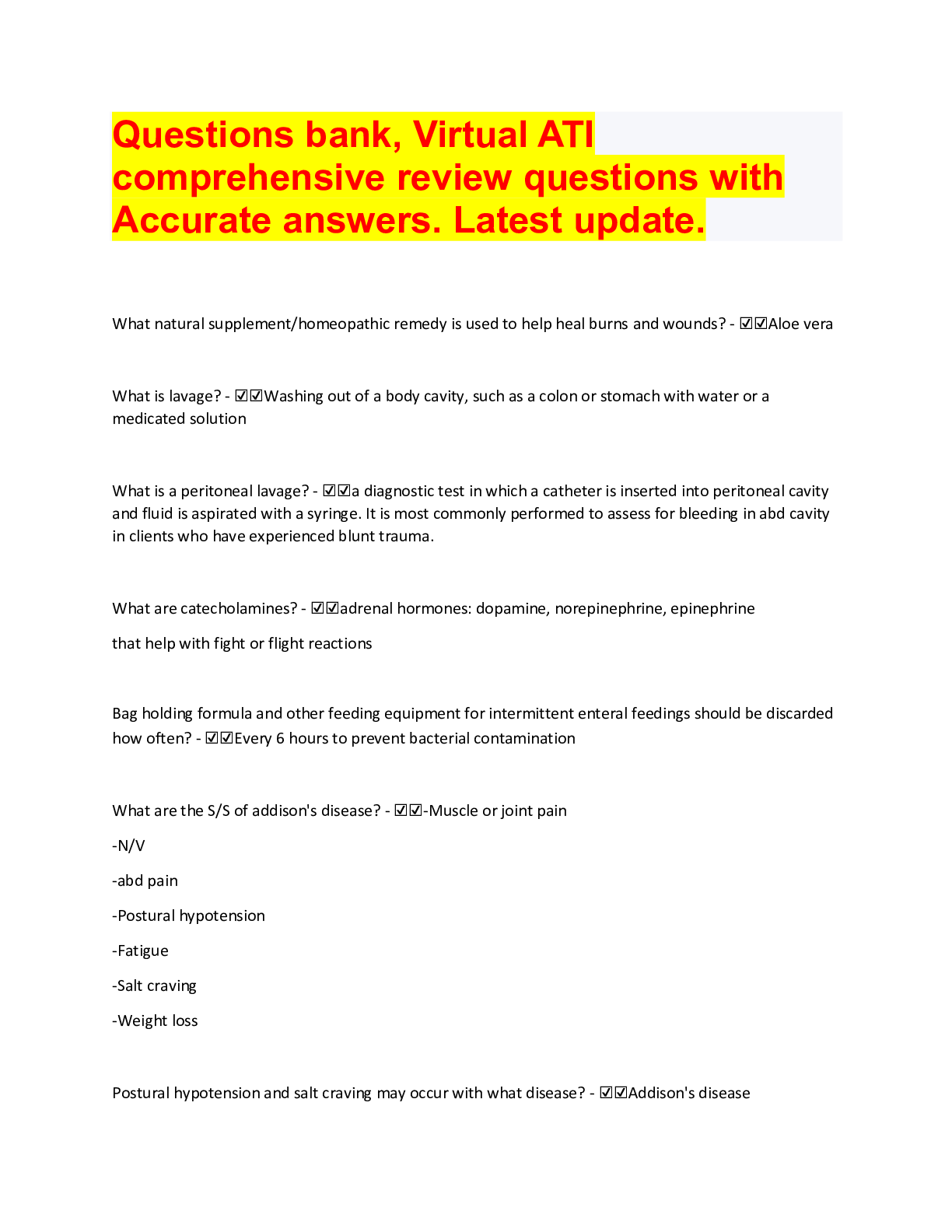
Also available in bundle (1)

NREMT EXAM BUNDLE. QUESTIONS WITH ACCURATE ANSWERS, LATEST UPDDATES
COMPRISES OF ALL EXAMINABLE NREMT EXAM QUESTIONS WITH ACCURATE ANSWERS.
By bundleHub Solution guider 1 year ago
$32
25
Reviews( 0 )
Document information
Connected school, study & course
About the document
Uploaded On
Aug 12, 2022
Number of pages
93
Written in
Additional information
This document has been written for:
Uploaded
Aug 12, 2022
Downloads
0
Views
89

